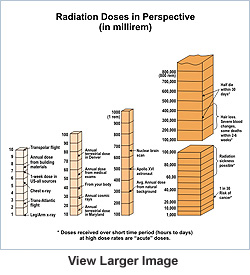|
|
Home > About NRC
> Radiation Protection > Radiation
All Around Us > Doses in Our Daily Lives
Doses in Our Daily Lives
 On average, Americans receive a dose of about 0.3 rem (300 millirem) each year from natural background radiation. Most of this exposure comes from radon in the air, with smaller amounts from cosmic rays and the Earth itself. (The chart to the right shows these radiation doses in perspective.) In general, a yearly dose of 0.36 rem (360 millirem) from all radiation sources has not been shown to cause humans any harm.
On average, Americans receive a dose of about 0.3 rem (300 millirem) each year from natural background radiation. Most of this exposure comes from radon in the air, with smaller amounts from cosmic rays and the Earth itself. (The chart to the right shows these radiation doses in perspective.) In general, a yearly dose of 0.36 rem (360 millirem) from all radiation sources has not been shown to cause humans any harm.
On this page:
Doses from Medical Procedures
| Medical Procedure Doses |
| Procedure |
Dose (mrem) |
| X-Rays |
|
Abdomen |
40 |
Chest |
6 |
Pelvis |
60 |
Dental |
3 |
Mammography |
170 |
CT
(full body) |
130 |
| Nuclear Medicine |
400 |
|
In addition to natural
background radiation, Americans receive an average dose of
about 0.06 rem (60 millirem)
per year from man-made
sources of radiation, including medical, commercial, and
industrial sources. Of these sources, medical procedures provide
the largest contribution to human exposure to man-made radiation.
For example, a chest x-ray typically gives a dose of about
0.006 rem (6 millirem), as shown in the table to the left.
Among these medical procedures, x-rays, mammography, and CT use radiation or perform functions similar to those of radioisotopes. However, they do not involve radioactive material and, hence, are not regulated by the U.S. Nuclear Regulatory Commission (NRC). Instead, most of these procedures are regulated by State health agencies. In fact, among these procedures, the NRC and its Agreement States only license and regulate the possession and use of radioactive materials for nuclear medicine. |

Radioactivity in Food
| All organic matter (both plant and animal) contains some small
amount of radiation from radioactive potassium-40 (40K),
radium-226 (226Ra), and other isotopes. In addition,
all water on Earth contains small amounts of dissolved uranium
and thorium. As a result, the average person receives an average
internal dose of about 30 millirem of
these materials per year from the food and water that we eat
and drink, as illustrated by the following table. (Amounts are
shown in picocuries per kilogram.) |
| Natural Radioactivity
in Food |
| Food |
40K (pCi/kg) |
226Ra (pCi/kg) |
| Bananas |
3,520 |
1 |
| Carrots |
3,400 |
0.6 - 2 |
| White Potatoes |
3,400 |
1 - 2.5 |
| Lima Beans (raw) |
4,640 |
2 - 5 |
| Red Meat |
3,000 |
0.5 |
| Brazil Nuts |
5,600 |
1,000 - 7,000 |
| Beer |
390 |
--- |
| Drinking Water |
--- |
0 - 0.17 |
|

Personal Annual Radiation Dose Calculator
We live in a radioactive world, and radiation has always been all around us as a part of our natural environment. As explained above, the annual average dose per person from all sources is about 360 mrem, but it is not uncommon for any of us to receive more than that average does in a given year (largely as a result of medical procedures). To find your personal annual radiation dose, use the interactive Personal Annual Radiation Dose Calculator or this printer friendly worksheet  . .
 |
